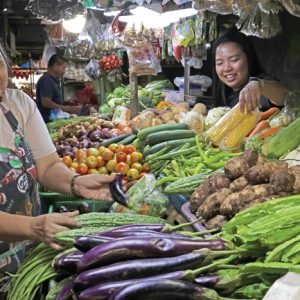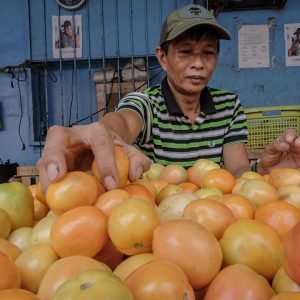
IF oil prices shoot up to $90 to $100 per barrel, the country’s inflation rate could breach the government target this year and next year, according to the Bangko Sentral ng Pilipinas (BSP).
Based on the Monetary Policy Report (MPR), the BSP estimated that should oil prices reach $90 per barrel, inflation could reach 4.1 percent this year and 4.4 percent next year.
Under a $100 per barrel scenario, the BSP estimated that inflation could average 4.5 percent this year and 4.7 percent in 2026.
“Inflation could breach the 2–4 percent target range if Dubai crude oil prices average above $90 per barrel in 2025 and 2026,” the BSP said in the MPR.
“These oil price scenarios consider only direct effects and do not incorporate potential second-round effects on transport fares, food prices, and wage increases,” it added.
The BSP said global crude oil prices are expected to decelerate in 2025 and 2026. The BSP now projects Dubai crude to average $70.05 per barrel this year and $68.15 per barrel in 2026.
However, expectations that global demand would be weak and there was a likelihood of global oversupply, the BSP said, delayed the increase in oil production, which could raise prices in the near-term.
“[This] led to a delay in the anticipated increase in oil production by the Organization of the Petroleum Exporting Countries and other partner countries [OPEC+],” the BSP said.
Balance of risks
Apart from higher global oil prices, supply-side issues continue to hound domestic commodity prices. The BSP said the balance of risks on the country’s inflation outlook this year and next year continue to be tilted to the upside.
Using a 90-percent confidence interval, BSP estimated that for 2025 and 2026, there was a 50-percent chance that inflation would breach the government’s inflation target.
“The probability of inflation breaching the high end of the target range is higher for these [2025 and 2026] years. The probability of inflation breaching the low end of the target range over the policy horizon remains low,” the BSP said.
BSP said supply side constraints affecting food could lead to a faster increase in inflation. Food accounts for 34.78 percent of the Consumper Price Index (CPI) for all income households.
These supply side constraints include the lingering impact of last year’s El Niño phenomenon, African Swine Fever (ASF), and Avian Flu that threaten local production.
ASF affects pork supply while the avian flu affects poultry supply. These are part of Meat and Other Parts of Slaughtered Land Animals, which accounts for 6.43 percent of the CPI.
The BSP also expects fish supply to become “insufficient” due to a decline in “local output, lower imports, high input costs,” and bad weather.
This could prompt an increase in the price of the commodity. In the CPI, Fish and Other Seafood had a weight of 5.66 percent.
Further, BSP said the impact of La Niña and the eruption of Mt. Kanlaon could also lead to a decline in domestic sugar supply. In the CPI, Sugar, Confectionery and Desserts has a weight of 1.05 percent.
“Under this risk scenario, elevated commodity prices are assumed to persist until Q1 [first quarter] 2025. An overall medium probability is assigned to this risk, considering the relative weights of these commodities in the CPI basket,” BSP said.
Rice tariffs
However, the tariff reduction on rice imports could give Filipinos a reprieve from high rice prices. Rice prices has a weight of 8.87 percent of the CPI for all income households.
This has a “medium probability” given expectations that the formalization of the reduced tariff through Executive Order no. 62, dated 20 June 2024. This could also lead to lower prices of domestically produced rice.
“Inflation is expected to ease amid the direct impact of the tariff reduction reflected in the baseline forecast. However, the estimated impact is lower compared to the previous round, given the gradual decline in domestic rice prices,” BSP said.
Apart from food, BSP also expects transport fares in jeepneys, trains, and taxis to increase and affect average inflation nationwide. Transport has a 9.03 percent weight in the CPI.
The BSP noted that petitions to raise minimum fares for jeepneys filed last year will be implemented in the first quarter of 2025.
Further, the Manila Metro Rail Transit (MRT)-3 management also filed a P3 increase in the minimum fare to P16. The expectation is for the fare hike to take effect in the first quarter of 2025.
In addition, the Land Transportation Franchising and Regulatory Board (LTFRB) is reviewing the request from taxi operators to increase fares nationwide.
BSP noted that in previous taxi fare hikes, the LTFRB approved a P5 increase in September 2022 and the same level of increase in March 2024.
The report stated that should authorities approve the fare hike, the increase will also take effect in the first three months of the year.
“An overall medium probability is assigned to the transport fare risk based on the CPI weights of the items considered. The table below presents the assumed fare adjustments,” the BSP said.
The BSP also expects electricity rates to increase due to higher generation charges that are usually passed on to consumers.
In July 2023, the Supreme Court (SC) nullified the previous cap on Wholesale Electricity Spot Market (WESM) prices for November 2013 and December 2013.
“The risk scenario assumes that this adjustment will be distributed evenly over the next three years and considers other possible electricity charges adjustments. A high probability is assigned to this risk following the SC ruling,” the BSP said.
The high commodity prices are expected to keep demand subdued. This means the economy could post “below potential” growth over the near-term.
The BSP noted that in 2024, the contraction in agriculture and a moderation in industry and services may have led to slower-than-expected GDP growth.
On the demand side, weather disturbances led to a slowdown in tourism and leisure-related spending, particularly private consumption and services exports, also affected GDP growth.
Image credits: Bernard Testa







